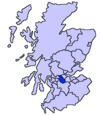Greengairs
| Greengairs | |
|---|---|
 Road through Greengairs | |
Location within North Lanarkshire | |
| Population | 520 (2022)[1] |
| Council area | |
| Country | Scotland |
| Sovereign state | United Kingdom |
| Police | Scotland |
| Fire | Scottish |
| Ambulance | Scottish |
Greengairs is a village in North Lanarkshire, Scotland.[2] Greengairs is shown on a map by Roy c.1754 under the name of Green Geirs.[3] In toponymy the name means "green strips of grass".[4] Lying 3 miles (5 km) southeast of Cumbernauld and 3 miles (5 km) north east of Airdrie, the village consists mainly of local authority housing. Between them Greengairs and Wattston have about 1,190 residents.[5]
It developed in the nineteenth century due to increased coal mining and quarrying. Ironstone was first mined by the Summerlee Iron Company in the 1840s.[6] It was in the parish of New Monkland or East Monkland. It also historically had its own school; the teachers had a house but no salary.[7] The village was badly affected by the Stanrigg Mining Disaster[8] where, in July 1918, a collapse led to the deaths of 19 miners, 6 of whom came from Greengairs.[9]
Greengairs power station opened in 1996, and is powered by methane produced by biodegrading materials from a large landfill site developed since 1990 in former open cast workings situated to the south of the village.[10] Greengairs is the largest landfill site in Scotland, handling waste from Glasgow and Edinburgh.[11] Greengairs has 6000m of pipes with biogas fed by 90 gas wells.[12]
References
[edit]- ^ "Mid-2020 Population Estimates for Settlements and Localities in Scotland". National Records of Scotland. 31 March 2022. Retrieved 31 March 2022.
- ^ "OS 25 inch, 1892-1905". National Library of Scotland. Ordnance Survey. Retrieved 9 June 2017.
- ^ "Roy's map of the Lowlands". National Library of Scotland. Retrieved 3 January 2018.
- ^ Drummond, Peter, John (2014). An analysis of toponyms and toponymic patterns in eight parishes of the upper Kelvin basin (PDF). Glasgow: Glasgow University. p. 350. Retrieved 3 July 2017.
{{cite book}}: CS1 maint: multiple names: authors list (link) - ^ "Estimated population of localities by broad age groups, mid-2012" (PDF). Retrieved 3 January 2018.
- ^ "Airdrie Villages". Monklands Memories. Retrieved 3 January 2018.
- ^ Begg, James (1845). The new statistical account of Scotland (Vol 6 ed.). Edinburgh and London: William Blackwood and Sons. pp. 246–247. Retrieved 3 January 2018.
- ^ "OS 25 inch, 1892-1905". National Library of Scotland. Ordnance Survey. Retrieved 9 June 2017.
- ^ "Stanrigg 9th July 1918". Scottish Mining Website. Retrieved 3 January 2018.
- ^ "Greengairs". Gazetteer for Scotland. Retrieved 22 December 2012.
- ^ "Biomass Energy in Scotland". Renewable Energy In Scotland. Scots Renewables. Retrieved 8 January 2018.
- ^ "Greengairs; Scotland". Biomass Case Studies. University of Strathclyde (Energy Systems Research Unit). Retrieved 8 January 2018.


